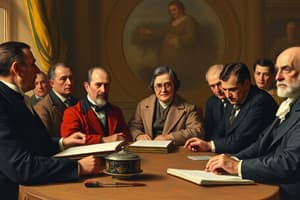Podcast
Questions and Answers
Which of the following principles was advocated by President Woodrow Wilson as a foundation for the League of Nations?
Which of the following principles was advocated by President Woodrow Wilson as a foundation for the League of Nations?
- Isolationist policies to avoid future wars
- Economic protectionism for member states
- Military alliances between major powers
- Self-determination for countries (correct)
The League of Nations was highly successful in preventing World War II.
The League of Nations was highly successful in preventing World War II.
False (B)
What was the concept of 'collective security' as intended within the framework of the League of Nations?
What was the concept of 'collective security' as intended within the framework of the League of Nations?
Members protect each other if invaded
One of the League of Nations' proposed methods to prevent war was to stop ______ with any country that declared war.
One of the League of Nations' proposed methods to prevent war was to stop ______ with any country that declared war.
Match the following countries with their relationship to the League of Nations:
Match the following countries with their relationship to the League of Nations:
What action did the League of Nations take in the 1925 dispute between Greece and Bulgaria?
What action did the League of Nations take in the 1925 dispute between Greece and Bulgaria?
The League of Nations successfully achieved complete disarmament among its member states.
The League of Nations successfully achieved complete disarmament among its member states.
Name one specific way the League of Nations worked 'for a better world,' besides preventing wars.
Name one specific way the League of Nations worked 'for a better world,' besides preventing wars.
The League of Nations depended heavily on ______ and France, which sometimes put their own self-interests ahead of the League's aims.
The League of Nations depended heavily on ______ and France, which sometimes put their own self-interests ahead of the League's aims.
Which of the following was a success of the League of Nations in the 1920s?
Which of the following was a success of the League of Nations in the 1920s?
Flashcards
LON idea
LON idea
Countries work together, self-determination, international organization creation
Collective security
Collective security
Members protect each other if invaded.
Economic sanction
Economic sanction
Stop trading with aggressors.
LON successes (1920s)
LON successes (1920s)
Signup and view all the flashcards
LON failures
LON failures
Signup and view all the flashcards
LON Covenant
LON Covenant
Signup and view all the flashcards
Aims of the League of Nations
Aims of the League of Nations
Signup and view all the flashcards
Study Notes
- League of Nations, often abbreviated to LON
Idea Behind the LON
-
Emerged after the terrible destruction caused by war to prevent future wars
-
President Woodrow Wilson of the USA proposed key principles
-
Self-determination for countries had to be applied
-
Countries must collaborate
-
Establishing an international orgainzation called the League of Nations
-
A Covenant was formed so the League of Nations would act as a judge for disagreements between member states, with both parties agreeing to accept the decision.
-
Collective security meant members would protect each other if invaded
-
If a country declared war, trade would stop to cut off supplies and member states would send troops to end the conflict
Aims of the League of Nations
- Encourage countries to collaborate
- Promote disarmament in all countries
- Improve living and working conditions worldwide
Successes in 1920
- Settled border disputes arising from post-war land division
- Countries accepted League of Nations' decisions without resistance after a country invaded another
- Fought poverty
- Defeated disease and injustice through freeing slaves worldwide
- Helped prisoners of war return to their countries
- Improved working conditions for children and workers around the world
Failures of the LON
- Proved ineffective as a peacekeeping organization especially in the 1930s, which hurt its reputation
- The fact that the USA never joined was a membership failure
- Japan left the League (1919-1933)
- Italy also left (1919-1937)
- Germany's membership lasted from 1926-1933
- Russia's membership was between 1934-1939
- Depended on Britain and France, who would sometimes prioritize their own interests, leading to failures
- Unable to prevent the Second World War, its ultimate failure
Border Disputes and Resolution
- 1921 - Sweden and Finland fought for control of the Aaland Islands; the League of Nations decided the islands should be under Finland's control, which Sweden accepted
- 1925 - Greece invaded Bulgaria after troops were killed; the League of Nations ordered Greece to withdraw and compensate Bulgaria, which Greece did
Working for a Better World
- Helped 400,000 prisoners return to their countries
- The International Labour Organization limited children's working hours and was designed to improve working conditions for workers
- Defeated diseases and freed 200,000 slaves
1920s' Successes and 1930s' Failures
- The absence of the USA made cooperation difficult; so the League depended heaviliy on Britain and France, who would often put their own self-interest before the aims of the League.
Studying That Suits You
Use AI to generate personalized quizzes and flashcards to suit your learning preferences.




